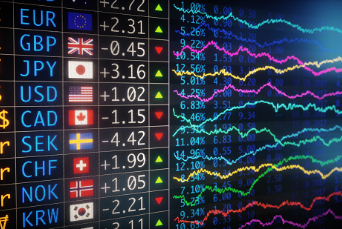
Alina Haynes
Apr 27, 2022 16:49

The futures market is dynamic and expansive. It enables individuals to trade futures contracts on various commodities, ranging from sugar and cotton to energy and interest rates. Individuals are not restricted to a single sector of the global economy or prosperous economic periods. Specific futures contracts are well-known for their high volatility and wide price swings. It is not uncommon for certain futures to trade lower in the morning but more elevated at the close.
Expert futures traders do not trade alone, and they frequently make decisions based on technical analyses and strategy. Traders gain an advantage when executing trades by adhering to a well-reasoned and backtested strategy. However, what is the most effective futures trading strategies? Let us investigate.
Futures are widely used financial contracts in which both parties agree to transact an asset at a pre-specified price and on a pre-determined future date. Unlike with options, where the buyer has the right but not the responsibility to exercise his option, traders who trade futures must adhere to the contract's conditions by the contract's expiration date, regardless of the current market price.
A futures contract's price is determined by its underlying asset, current market price, and expiration date. Common commodities such as gold, oil, copper, and natural gas are popular underlying assets for futures contracts and financial instruments such as currencies and stocks.
Futures contracts are standardized, meaning that the underlying item's quantity is always specified accurately. For instance, a futures contract on the British pound is worth precisely GBP 62,500, an agreement on natural gas is for 10,000 MMBtu (million British thermal units), a contract on crude oil is worth 1,000 US barrels, and a gold warranty is worth 100 fine troy ounces.
Futures contracts are most frequently used for risk management and speculation. For instance, a farmer may choose to hedge against dropping maize prices by purchasing a corn futures contract with a fixed price and expiration date. Thus, the farmer knows the price at which his product can be sold in advance.
Speculators utilize futures contracts to gamble on the market and benefit from the underlying instrument's dropping or growing price. Most futures contracts are not held until their execution date because they can be traded on an exchange regularly. The underlying instrument's current market price determines the price of a futures contract.
Individuals can increase their chances of success by avoiding typical mistakes many beginning futures traders make. These include the following:
All successful futures traders employ a method to assist them in selecting deals and limiting losses. However, many traders will divert from or quit a trading strategy just when it begins to show promise. This allows for the infiltration of emotion into their Trading, resulting in losses.
Like all forms of trading, futures trading entails some risk, so it is critical to protect yourself. There are several ways to accomplish this, including the use of sell or purchase stops to keep your losses within a tolerable range or the use of hedging tactics such as buying options. Taking precautions to protect yourself will help you minimize losses while maximizing profits.
Trading futures takes good your full attention to effectively read and evaluate markets. While distractions are sometimes unavoidable, you want to have as little as possible when trading.
Markets are constantly shifting. Regardless of how good a trader you believe yourself to be, there is always a fresh thought that can help you enhance your performance. Too frequently, traders become entrenched in thinking they already know enough and are unwilling to learn anything new. As market conditions shift, this type of trader is left behind with only losses to show for their efforts. However, by remaining receptive to new ideas, you may change with the markets—and profit consistently regardless of what they do.
A successful futures trader profits in all market conditions. Traders come from a diverse range of backgrounds and lives, although the majority of successful futures traders are:
Great futures traders make their own decisions rather than following the herd. They watch the markets and the world to guide their trading judgments. When the market falls, they resist panic and pursue bearish techniques to profit. Additionally, they avoid being excessively greedy in rising markets, when many investors behave as if the market will continue to increase indefinitely.
To become a successful futures trader, you must grasp technical and fundamental analysis and be able to apply them to trading opportunities in the spot market. If you are a novice, acquiring the requisite information and expertise may be an impossibly large endeavor. However, there is an abundance of knowledge available in books, publications, and futures-related websites. While learning, paper trading allows you to practice and refine your skills.
Futures traders that are successful never stop learning. Consider attending seminars or other educational activities that allow you to interact with traders and further your education.
When trading futures, information is critical. Ascertain that you can execute transactions 24 hours a day, have access to real-time quotations and market analysis software, and receive speedy executions. These technologies enable you to respond rapidly to shifting market conditions.
This effective futures trading strategy relies on price pullbacks, which happen during trending markets when the price drops below or above a resistance or support level, reverses, and returns to the level at which it was broken. The term "resistance levels" refers to price levels that the price has had difficulty breaking above, and support levels are price marks where the market experienced trouble breaking below.
During an upswing, the price breaks over a previously set resistance level reverse and retests the resistance level. Following the retest, you may enter a prominent position in the direction of the fundamental uptrend.
During a downtrend, the price falls below a previously established support level, reversing and returning to the support level. This is a pullback, and it is possible to enter with a short position in the direction of the underlying downtrend.
Pullbacks frequently occur when traders begin to take profits, causing the futures price to move in the opposite direction of the breakout. Traders who missed the first price movement might wait for the cost to return to the resistance or support level to enter at a more advantageous price, which will push prices higher again.
You can purchase futures contracts if you anticipate an underlying commodity's price increasing over a specified period. If your prognosis regarding the direction and timing of the price shift is correct, you can sell the futures contracts for a profit later. However, if the price falls, your trade will be a loss. Due to the leverage effect, your gains and losses may exceed your initial margin deposit.
In day trading, breakout trading is a common strategy. When the price of underlying asset swings outside of its established trading range, this is referred to as a breakout. Breakout trading aims to capitalize on market volatility as prices break through support and resistance levels, trendlines, and other technical levels.
Often, the breakout movement is accompanied by a surge in volume. You're looking for a small trading range or channel with reduced volatility here.
Following a breakout, the market is highly volatile. This is due to the execution of multiple pending orders. You might attempt to profit from this increase in volatility by taking a position in the breakout direction. The general strategy is to sell when prices fall below support and buy when prices rise above resistance.
Spread Trading is a strategy that entails purchasing one future contract and selling another futures contract at a later date. This strategy aims to profit from an unexpected shift in the relationship between the buying price of one futures contract and the selling price of another futures contract.
Spread Trading reduces your trading risk. Each spread functions as a hedge, and trading the difference between two futures contracts exposes a trader to fewer risks. Additionally, spread trading is unaffected by market volatility.
Trading the range is a strategy that involves changing the rebound off of significant support and resistance levels on a chart. Specific markets, such as equities, prefer to trend, while others, such as currencies, prefer to trade in a range.
The majority of market participants remain human beings with emotions and memories. When the market cannot break above a particular price level, market players refer to it as a resistance level. When the price reverts to the previous level, some traders will take profits, and others will open short positions, which will boost selling pressure on the financial instrument and likely drive the price lower.
On the other side, if the price cannot break below a certain level and reverts to that level, market participants who have been shorting the market may take profits. In contrast, others may begin buying at those lower prices, which will increase buying pressure on the financial instrument and likely cause the price to rise. These are known as support levels.
Selling something you do not own is frequently a stumbling block for traders unfamiliar with futures. However, it is easily overcome. Bear in mind that a futures contract is nothing more than a pledge to sell or purchase an asset at a future date. Thus, when you sell to open a position, all you are committing to is the forthcoming sale at that price. You are not required to own the underlying commodity or financial instrument throughout this period.
Selling a futures contract as an initial position is just as straightforward as buying one. You sell because you feel the price will fall. If you've ever traded stocks, you'll be relieved to learn that shorting futures involves no borrowing or lending fees. Simply put, you sell as quickly as you purchase.
If your market direction and timing are correct and prices decrease, you can profit from your short position simply by purchasing the identical contract. If the rebounds the place and rallies, you will incur a loss upon exiting—and the loss may be more than the amount you invested in the trade.
While most of the futures trading methods discussed in this article are technical in nature, you should be aware that the majority of high-volatility price swings result from fundamental changes in the underlying instrument. Fundamentals establish and break trends and significant support and resistance levels.
Professional futures traders must stay current on the fundamentals of the financial asset they trade. Fundamental traders, on average, base 80% of their trading decisions on fundamentals and 20% on technicals.
One of the primary disadvantages of fundamental analysis is that it does not provide precise price levels upon which to trade, where technical analysis comes in. Fundamental analysis is used to evaluate whether to buy or sell, while technical analysis establishes profit objectives and stop-loss levels.
Trend-following methods are some of the best futures trading tactics. They (usually) work, have a track record of success and are relatively simple to follow.
What is, therefore, a trend-following strategy? As their name implies, these techniques seek to enter the direction of the underlying trend. A trend-following approach will look exclusively for appropriate long positions if the trend is upward. Similarly, a trend-following strategy would seek out prospective short jobs if the movement is downward.
You may have heard the expressions "buy low, sell high" and "follow the trend." However, how can a trader determine whether to buy at a "low" and when to sell at a "high"?
To begin answering that critical topic, let's quickly review how trends develop. Price produces higher highs and lower lows during an uptrend, with each higher low marking a counter-trend move. These counter-trend moves occur due to profit-taking or when sellers begin to force an overstretched up-move lower.
During an upswing, the optimum moment to buy is at the higher low, i.e., the bottom of the market correction. This is the time when the underlying uptrend should re-establish itself. The same holds for downtrends, except that you would enter with a sell position at the tops of lower highs.
While it is undeniable that an excellent trading strategy can considerably increase your trading performance, there are also specific aspects and techniques to avoid. Here are the most critical ones:
The market's liquidity is contingent upon the presence of buyers and sellers at each price level. A highly liquid financial asset, such as the EUR/USD pair or blue-chip stocks such as Apple, has many market players willing to enter the market at nearly any price level around the current market price. This minimizes the security's or currency pair's volatility and the related trading risks. Even on small trading orders, illiquid financial instruments can experience significant price fluctuations, quickly resulting in substantial losses.
Scalping is a popular short-term trading strategy that seeks to profit from minor price swings on extremely short timescales. Scalping is a fast-paced and thrilling trading style that draws many traders, particularly those who are new to Trading. Regrettably, these traders frequently incur substantial losses. Scalping successfully requires experience, dedication, and steely nerves. Before getting started with scalping, you must first learn to trade profitably using longer-term trading strategies such as swing trading and day trading.
Each time you opt to hold a trade overnight or over the weekend, you risk being exposed to unfavorable market developments, which could result in losses. This is particularly true when trading on weekends.
If your trading strategy and risk management are well-defined, futures trading may be an extremely fascinating and lucrative endeavor. If you're new to Trading, give the pullback strategy a shot, and it is a well-liked trading strategy with a sizable following among retail futures traders. Additionally, we enjoy trend-following methods and Trading in the trend's direction.

Apr 27, 2022 15:20

May 05, 2022 14:44